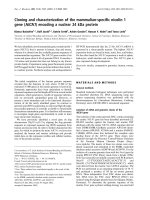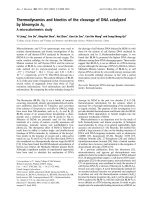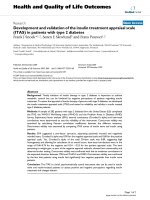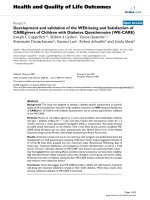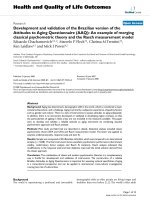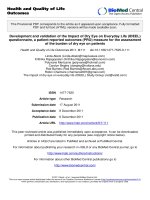Báo cáo y học: " Translation and validation of the Korean confusion assessment method for the intensive care uni" pot
Bạn đang xem bản rút gọn của tài liệu. Xem và tải ngay bản đầy đủ của tài liệu tại đây (189.75 KB, 4 trang )
RESEARCH ARTICLE Open Access
Translation and validation of the Korean
confusion assessment method for the
intensive care unit
Eun Young Heo, Byoung-Jo Lee, Bong-Jin Hahm, Eun Hee Song, Han-A Lee, Chul-Gyu Yoo, Young Whan Kim,
Sung Koo Han, Young-Soo Shim and Sang-Min Lee
*
Abstract
Background: Delirium is a common problem and associated with poor outcomes in intensive care unit (ICU)
patients. Diagnosis of delirium in ICU patients is limited and usually underdiagnosed by physicians. The Confusion
Assessment Method for the Intensive Care Unit (CAM-ICU) is one of the most widely used screening methods for
detection of ICU delirium. Our goal was to translate and validate the CAM-ICU for use in the Korean ICU setting.
Methods: Translation of the CAM-ICU was done according to the guidelines suggested by the Translation and
Cultural Adaptation Group. For validation and interrater reliability assessment of the Korean CAM-ICU, two nurses
independently assessed delirium in ICU patients and the results were compared with the reference evaluation,
which was done by a psychiatrist using the Diagnostic and Statistical Manual of Mental Disorders IV (DSM-IV).
Results: Twenty-two patients were evaluated by two nurses and one psychiatrist expert independently. During the
study period, we have continuousl y educated study nurses. Based on DSM-IV criteria, 16 out of 22 (72.7%) patients
developed delirium. The sensitivities of the two nurses’ evaluations using the Korean CAM-ICU were 89.80% for
nurse 1 and 77.40% for nurse 2. Their specificities wer e 72.40% and 75.80% and their overall accura cy was 83.33%
and 88.37% respectively. The Korean CAM-ICU was done with reasonable interrater reliability between nurse 1 and
nurse 2 ( = 0.81, p < 0.001).
Conclusions: The Korean CAM-ICU showed good validity and could be incorporated into clinical practice in
Korean ICUs.
Trial registration: ISRCTN: ISRCTN50265663
Background
Delirium is defined in the Diagnostic and Statistical
Manual of Mental Disorders IV (DSM IV) as a distur-
bance of consciousness with inattention accom panied by
a change in cognition or perceptual disturbance that
develops over a short period and fluct uates over time
[1]. Delirium is a common problem in patients in the
intensive care unit (ICU) because of critical illness, med-
ications, v arious procedures, and numerous risk factors
[2]. Ely et al. reported that delirium occurred in between
81.7% and 87% of patients during their ICU stay [3-5].
Delirium itself is an independent predictor of mortality
and longer hospital stay in ICU patients [5-7]. There-
fore, the Society of Critical Care Medicine (SCCM)
guidelines recommend routine assessment for the pre-
sence of delirium in ICU patients [8].
Despite the high prevalence and clinical importance of
delirium in the ICU, detection of ICU delirium is lim-
ited, especially in mechanically ventilated patients, and
delirium often goes undiagnosed by physicians [9,10].
The Confusion Assessment Method for the ICU (CAM-
ICU) is a valid, reliable tool for detection of ICU delir-
ium and is also used in nonverbal mechanically venti-
lated patients. It is simple, can be assessed by
nonpsychiatrists with minimal training and takes only a
few minutes [3,4,11]. Because of these ben efits, the
CAM-ICU has been translated into over a dozen
* Correspondence:
Seoul National University College of Medicine, 103 Daehangno, Jongno-gu,
Seoul, 110-744, Republic of Korea
Heo et al. BMC Psychiatry 2011, 11:94
/>© 2011 Heo et al; licensee BioMed Central Ltd. This is an Open Access article distributed under the terms of the Creative Commons
Attribution License ( which permits unrestricted use, distribution, and reproduction in
any medium, provided the original work is properly cited.
languages but a Korean version of the CAM-ICU is not
yet available. In this study, we attempted to translate
and validate the CAM-ICU for practical use in the Kor-
ean ICU setting.
Methods
Patients
The Seoul National University Hospital institutional
review board approved this study, and written informed
consent was obtained from patients or their surrogates.
The study population included both ventilated and non-
ventilated adult medical ICU patients admitted to the
Seoul National University Hospital for longer than 24
hours. Exclusion criteria included patients who
remained comatose throughout the investigation or
were moribund, or who had a history of psychosis or
neurologic disease that would confound the diagnosi s of
delirium. We also excluded the patient who had been
already diagnosed as delirium before assessment and
been prescribed antipsychotics. The study was con-
ducted in March 2009.
Translation and Back-translation
After permission from Ely et al., translatio n of the
instrument was carried out according to the guidelines
suggested by the Translation and Cultural Adaptation
group [12,13]. The CAM-ICU was translated into Kor-
ean by the authors–doct ors of pulmonology, psychia-
trists and Masters s tudents majoring in English. Each
carried out their translation independently and then
these were discussed. The final Korean version was
given to a professi onal translator for back-translation to
English without any information about the original ver-
sion. The back-translated version was sent to Ely et al.
for approval and acceptance of the Korean version.
Validation of Delirium Assessment and Interrater
Reliability
One research nurse and another experienced nurse spe-
cializing in inte nsive care independently c onducted
delirium assessment in the enrolled patients using the
Korean version of the CAM-ICU (Korean CAM-ICU).
For reference standard evaluation, an experienced psy-
chiatrist (L-BJ) specializing in consultation psychiatrics
independently assessed the delirium using the DSM-IV
criteria. All assessments were done between three and
seven o’clock in the afte rnoon to a void any bias arising
from changes in patients’ condition.
To validate the Korean version, we compared the Kor-
ean CAM-ICU users to the psychiatrist ratings of delir-
ium using the DSM-IV criteria as the reference
standard. For interrater reliability, we compared the
Korean CAM-ICU r atings between the two nurses by
coefficient.
During the study period, we had times to discuss
about the rating results with two nurses and the psy-
chiatrist. In addition, we continuously educated study
nurses regarding any mistakes or misconceptions. How-
ever, any rating results which had been already made
were not changed after these processes.
Results
Patient Characteristics
During the 1-month study period, assessments were
conducted for 16 days and 22 patients were analyzed.
On each assessment day, we screened all patients
admitted to medical ICU and enrolled patients who
were satisfied with inclusion criteria.
The baseline characteristics of the patients are sum-
marized in Table 1. Most patients (63.6%) were male
and the median age was 68 years (range: 19-87). The
most common cause o f ICU admission (40.9%) was
acute respiratory distress syndrome (ARDS). The med-
ian APACHE (Acute Physiology and Chronic Hea lth
Evaluation) II at admission was 25.5 (range: 9-39). Based
on DSM-IV criteria, 16 out of 22 (72. 7%) enrolled
patients developed delirium at least once during the eva-
luation period.
Interrater reliability and validity of the Korean CAM-ICU
Ninety-six paired comparisons were c onducted in 22
patients. Every enrolled patient was assessed more than
once. Average number of assessments per patients was
4.7 and three patients were assessed more than 10
times.
For interrater reliability, nurse2 recorded feature 1 as
positive in all ratings, so w e were una ble to d etermine
the kappa value of feature 1. There were disagreements
about the feature 1 in 22 out of 96 case s (23%) betwe en
two nurses. The kappa values of the other features were
0.91, 0.60 and 0.64 respectively (Table2). The Korean
CAM-ICU was done with reasonable interrater reliabil-
ity, conside ring all 4 items, between nurse 1 and nurse 2
( = 0.81, p < 0.001).
Table 1 Baseline characteristics of the study population
Characteristics Frequency (Total N = 22)
Male(%) 14 (63.6)
Age, median(range) 68 (19-87)
Cause of ICU admission (%)
ARDS 9 (40.9)
Sepsis 3 (13.6)
Cardiac 3 (13.6)
Airway disease 4 (18.2)
Others 3 (13.6)
APACHEII, median(range) 25.5 (9-39)
Delirium using DSM-IV (%) 16 (72.7)
Heo et al. BMC Psychiatry 2011, 11:94
/>Page 2 of 4
Validity of the Korean CAM-ICU
Patients who were admitted to the medical ICU more than
24 hours previously were evaluated. During the study per-
iod, 74 paired evaluations were done between nurse 1 and
the psychiatric expert and 86 paired evaluations were done
between nurse 2 and the psychiatric expert. The sensitiv-
ities o f the two nurses’ evaluations using the Korean
CAM-ICU compared with the reference standard were
89.80% for nurse 1 and 77.40% for nurse 2. Their specifici-
ties were 72 .40% and 75.80% and th eir overall accuracies
were 83.33% and 88.37% respectively (Table 3).
Discussion
The sensitivity and specificity of the Korean CAM-ICU
was 89.8% and 77.4%, respectively, for nurse 1 and
72.4% and 75.8% for nurse 2. Overall agreement ()
between nurse 1 and nurse 2 was 0.81 (p < 0.001). Com-
pared with the original validation study of the CAM-
ICU (sensitivity = 100%, 93%, specificity = 98%, 100%)
[3], the Korean CAM-ICU showed a little lower sensitiv-
ity, spec ifici ty and kappa value. Ely et al., who originally
devised the CAM-ICU, explained that the as sesso rs also
interviewed patients’ family members to estimate their
baseline mental status [3,4]. In practice, interviews with
patients’ families are not easy and our study nurses
could not perform such family interviews. Feature 1 is
the one of 2 essential components for diagnose delirium
using the CAM-ICU. Therefore, knowing the patient’s
baseline mental status is very important thing. In this
study, we couldn’t get direct information o f patients’
baseline mental status from patients’ family and just
presumed from previous medical records. That might be
one of limitations of this study.
Ely et al. conducted a study to determine the feasibil-
ity of implementing the CAM -ICU [14]. Overall agree-
ment () between two different hospitals (one the
hospital where the original validation study of the
CAM-ICU was performed) was initially very low ( =
0.2, 0.03). However, this was much improved ( =0.92,
0.75, respectively) through an education period.
We have several limitations in this study. First, we
don’t have exact number and detailed clinical informa-
tion of excluded patients even though we screened all
patients admitt ed to medical ICU. This may have an
effect on the representativeness of enrolled patients
and the results of this study. Second, most patients
had been assessed several times and the data might be
correlated and independent. Third, the time between
the assessments was various. While so me patients had
been evaluated for 3 to 4 consecutive days, other
patients were evaluated at admission and then just
before leaving the ICU due to their medical
conditions.
Conclusions
The Korean version of the CAM-ICU showed good
validity and could be incorporated into clinical practice
in Korean ICUs. However, we should remember that
sufficient education and a feedback process are needed
during the introductory period. We hope that the Kor-
ean CAM-ICU will help clinicians detect delirium in the
ICU and eventually improve the outcome of patients in
the ICU through reducing the incidence of delirium and
its potential complications.
List of abbreviations
ICU: Intensive Care Unit; CAM-ICU: The Confusion Assessment Method for
the Intensive Care Unit; DSM-IV: The Diagnostic and Statistical Manual of
Mental Disorders IV; APACHE II: Acute Physiology And Chronic Health
Evaluation II; ARDS: Acute Respiratory Distress Syndrome.
Acknowledgements and Funding
This work was supported by a Grant (04-2008-006-0) from the Seoul National
University Hospital Research Fund. We thank Professor E. Wesley Ely for his
approval and research nurse specialists for their support in the ICU Delirium
and Cognitive Impairment Study Group. We are grateful to the doctors and
nurses of the medical intensive care units and all the translators. No authors
have financial interest.
Authors’ contributions
HEY: analysis of data and manuscript preparation. LBJ and HBJ: assessment
of delirium and analysis of data. SHE and LHA: important contribution to
acquisition of data. YCG, KYW HSK and SYS: interpretation of data and
manuscript review. LSM: study design, interpretation of data and manuscript
preparation.
All authors read and approved the final manuscript.
Competing interests
The authors declare that they have no competing interests.
Received: 4 October 2010 Accepted: 23 May 2011
Published: 23 May 2011
Table 2 Interrater reliability of each part of the Korean
CAM-ICU
Component of CAM-ICU N = 96*
Kappa p-value
Feature I Acute onset or fluctuating course . .
Feature II Inattention 0.91 <0.001
Feature III Disorganized thinking 0.60 <0.001
Feature IV Altered level of consciousness 0.64 <0.001
*
Interrater reliability measures across 96 paired comparison showed kappa of
0.81 (p-value <0.001).
Table 3 Validity of the Korean CAM-ICU
Rater No. of paired
observations
Sensitivity,
%
Specificity,
%
Overall
accuracy,%
Nurse_1* 78 89.80 72.40 83.33
Nurse_2* 86 77.40 75.80 88.37
Korean CAM-ICU comparisons were made to reference standard evaluations
by psychiatric expert using Diagnostic and Statistical Manual of Mental
Disorders, Fourth Edition, criteria.
Heo et al. BMC Psychiatry 2011, 11:94
/>Page 3 of 4
References
1. American Psychiatric Association: Diagnostic and statistical manual of
mental disorders (DSM-IV). Washington, DC: American Psychiatric
Association, 4 1994.
2. Girard TD, Pandharipande PP, Ely EW: Delirium in the intensive care unit.
Crit Care 2008, 12(Suppl 3):S3.
3. Ely EW, Inouye SK, Bernard GR, Gordon S, Francis J, May L, Truman B,
Speroff T, Gautam S, Margolin R, Hart R, Dittus R: Delirium in mechanically
ventilated patients: validity and reliability of the confusion assessment
method for the intensive care unit (CAM-ICU). JAMA 2001, 286:2703-2710.
4. Ely EW, Margolin R, Francis J, May L, Truman B, Dittus R, Speroff T,
Gautman S, Bernard GR, Inouye SK: Evaluation of delirium in critically ill
patients: validation of the Confusion Assessment Method for the
Intensive Care Unit (CAM-ICU). Crit Care Med 2001, 29:1370-1379.
5. Ely EW, Shintani A, Truman B, Speroff T, Gordon SM, Harrell FE Jr, Inouye SK,
Bernard GR, Dittus RS: Delirium as a predictor of mortality in
mechanically ventilated patients in the intensive care unit. JAMA 2004,
291:1753-1762.
6. Lin SM, Liu CY, Wang CH, Lin HC, Huang CD, Huang PY, Fang YF, Shieh MH,
Kuo HP: The impact of delirium on the survival of mechanically
ventilated patients. Crit Care Med 2004, 32:2254-2259.
7. Thomason JW, Shintani A, Peterson JF, Pun BT, Jackson JC, Ely EW:
Intensive care unit delirium is an independent predictor of longer
hospital stay: a prospective analysis of 261 non-ventilated patients. Crit
Care 2005, 9:R375-R381.
8. Jacobi J, Fraser GL, Coursin DB, Riker RR, Fontaine D, Wittbrodt ET,
Chalfin DB, Masica MF, Bjerke HS, Coplin WM, Crippen DW, Fuchs BD,
Kellenher RM, Marik PE, Nasraway SA Jr, Murray MJ, Peruzzi WT, Lumb PD:
Clinical practice guidelines for the sustained use of sedatives and
analgesics in the critically ill adult. Crit Care Med 2002, 30:119-141.
9. Peterson JF, Pun BT, Dittus RS, Thomason JW, Jackson JC, Shintani AK,
Ely EW: Delirium and its motoric subtypes: a study of 614 critically ill
patients. J Am Geriatr Soc 2006, 54:479-484.
10. Ely EW, Stephens RK, Jackson JC, Thomason JW, Truman B, Gordon S,
Dittus RS, Bernard GR: Current opinions regarding the importance,
diagnosis, and management of delirium in the intensive care unit: a
survey of 912 healthcare professionals. Crit Care Med 2004, 32:106-112.
11. Inouye SK, Bogardus ST Jr, Williams CS, Leo-Summers L, Agostini JV: The
role of adherence on the effectiveness of nonpharmacologic
interventions: evidence from the delirium prevention trial. Arch Intern
Med 2003, 163:958-964.
12. Beaton DE, Bombardier C, Guillemin F, Ferraz MB: Guidelines for the
process of cross-cultural adaptation of self-report measures. Spine 2000,
25:3186-3191.
13. Wild D, Grove A, Martin M, Eremenco S, McElroy S, Verjee-Lorenz A,
Erikson P: Principles of Good Practice for the Translation and Cultural
Adaptation Process for Patient-Reported Outcomes (PRO) Measures:
Report of the ISPOR Task Force for Translation and Cultural Adaptation.
Value Health 2005, 8:94-104.
14. Pun BT, Gordon SM, Peterson JF, Shintani AK, Jackson JC, Foss J,
Harding SD, Bernard GR, Dittus RS, Ely EW: Large-scale implementation of
sedation and delirium monitoring in the intensive care unit: a report
from two medical centers. Crit Care Med 2005, 33
:1199-1205.
Pre-publication history
The pre-publication history for this paper can be accessed here:
/>doi:10.1186/1471-244X-11-94
Cite this article as: Heo et al.: Translation and validation of the Korean
confusion assessment method for the intensive care unit. BMC Psychiatry
2011 11:94.
Submit your next manuscript to BioMed Central
and take full advantage of:
• Convenient online submission
• Thorough peer review
• No space constraints or color figure charges
• Immediate publication on acceptance
• Inclusion in PubMed, CAS, Scopus and Google Scholar
• Research which is freely available for redistribution
Submit your manuscript at
www.biomedcentral.com/submit
Heo et al. BMC Psychiatry 2011, 11:94
/>Page 4 of 4


